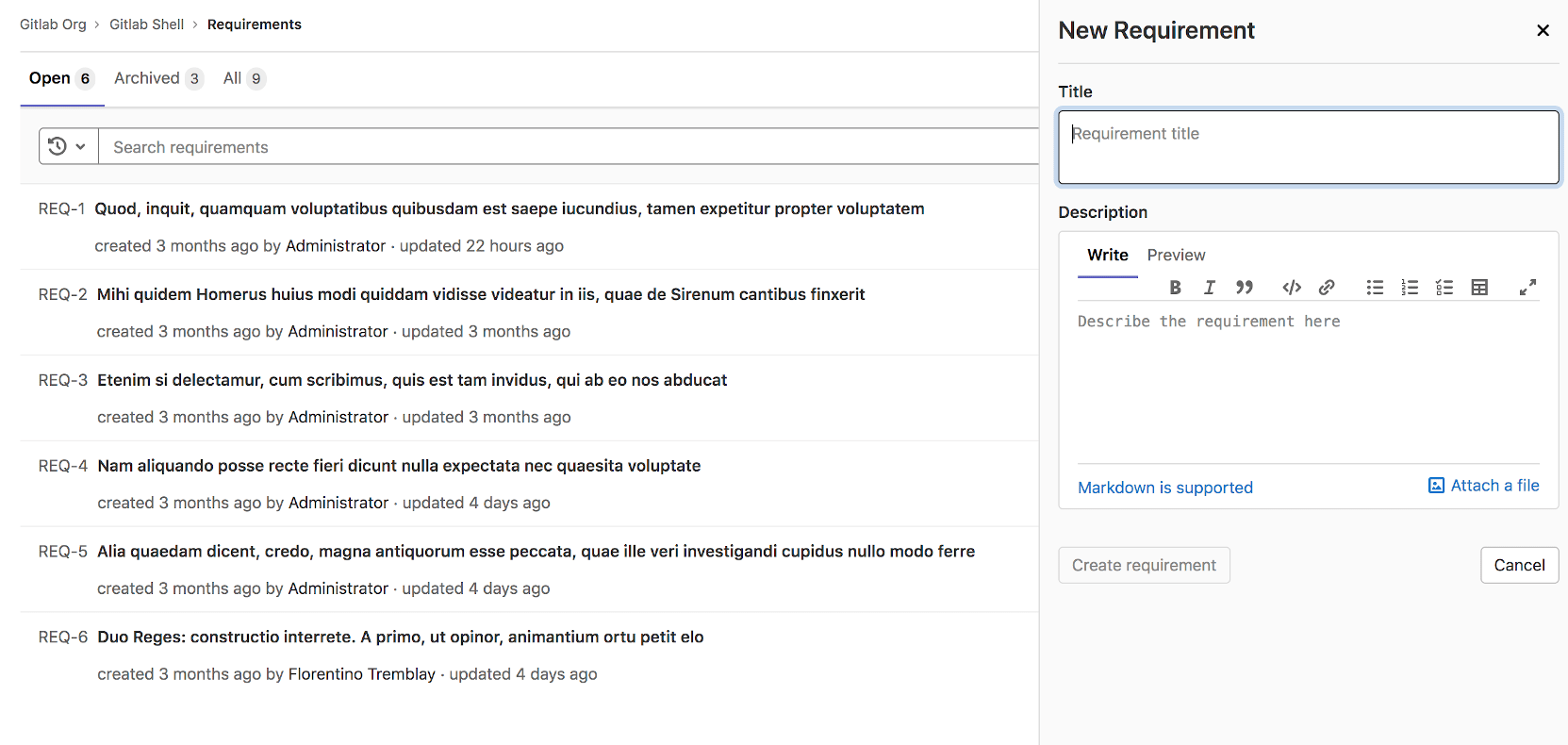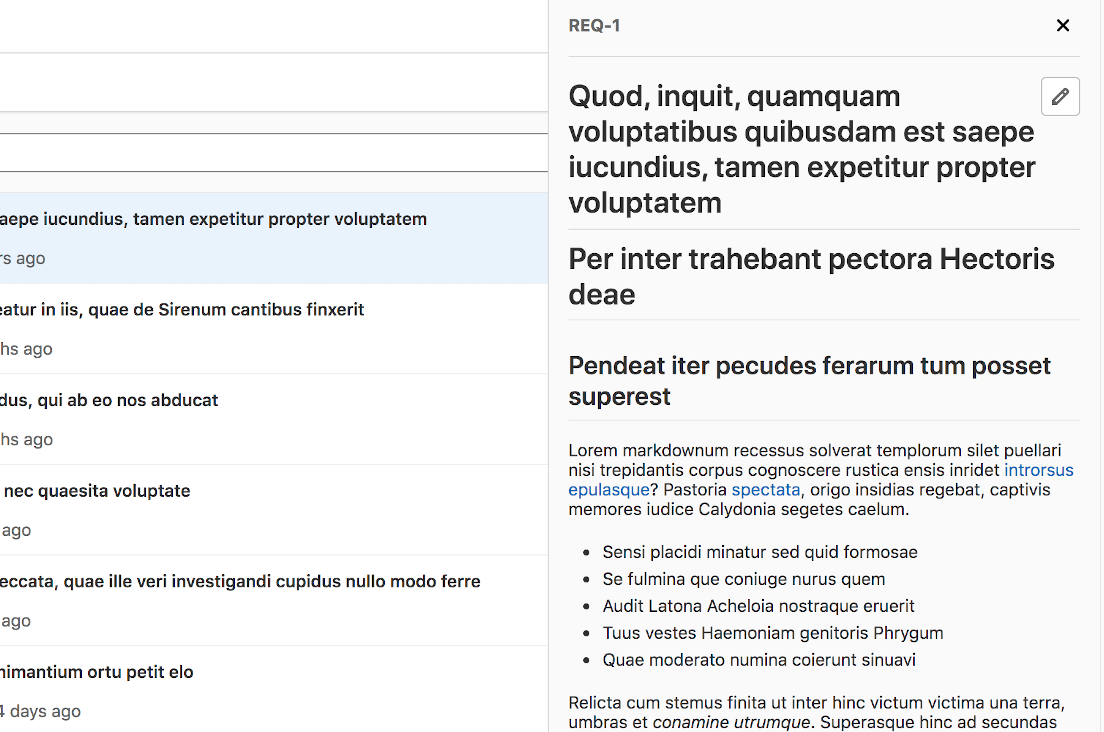Requirements management
DETAILS: Tier: Ultimate Offering: GitLab.com, Self-managed, GitLab Dedicated
With requirements, you can set criteria to check your products against. They can be based on users, stakeholders, system, software, or anything else you find important to capture.
A requirement is an artifact in GitLab which describes the specific behavior of your product. Requirements are long-lived and don't disappear unless manually cleared.
If an industry standard requires that your application has a certain feature or behavior, you can create a requirement to reflect this. When a feature is no longer necessary, you can archive the related requirement.
NOTE: Requirements and test cases are being migrated to work items. Issue 323790 proposes to link requirements to test cases. For more information, see Product Stage Direction - Plan.
For an overview, see Requirements Management.
For a more in-depth walkthrough see GitLab Requirements Traceability Walkthrough (Feb 2021).
Create a requirement
A paginated list of requirements is available in each project, and there you can create a new requirement.
Prerequisites:
- You must have at least the Reporter role.
To create a requirement:
- In a project, go to Plan > Requirements.
- Select New requirement.
- Enter a title and description and select New requirement.
You can see the newly created requirement on the top of the list, with the requirements list being sorted by creation date, in descending order.
View a requirement
You can view a requirement from the list by selecting it.
To edit a requirement while viewing it, select the Edit icon ({pencil}) next to the requirement title.
Edit a requirement
- Changed in GitLab 16.11: Authors and assignees can edit requirements even if they don’t have the Reporter role.
You can edit a requirement from the requirements list page.
Prerequisites:
- You must have at least the Reporter role or be the author or assignee of the requirement.
To edit a requirement:
- From the requirements list, select the Edit icon ({pencil}).
- Update the title and description in text input field. You can also mark a requirement as satisfied in the edit form by using the checkbox Satisfied.
- Select Save changes.
Archive a requirement
- Changed in GitLab 16.11: Authors and assignees can archive requirements even if they don’t have the Reporter role.
You can archive an open requirement while you're in the Open tab.
Prerequisites:
- You must have at least the Reporter role or be the author or assignee of the requirement.
To archive a requirement, select Archive ({archive}).
As soon as a requirement is archived, it no longer appears in the Open tab.
Reopen a requirement
- Changed in GitLab 16.11: Authors and assignees can re-open requirements even if they don’t have the Reporter role.
You can view the list of archived requirements in the Archived tab.
Prerequisites:
- You must have at least the Reporter role or be the author or assignee of the requirement.
To reopen an archived requirement, select Reopen.
As soon as a requirement is reopened, it no longer appears in the Archived tab.
Search for a requirement
You can search for a requirement from the requirements list page based on the following criteria:
- Title
- Author's username
- Status (satisfied, failed, or missing)
To search for a requirement:
- In a project, go to Plan > Requirements > List.
- Select the Search or filter results field. A dropdown list appears.
- Select the requirement author or status from the dropdown list or enter plain text to search by requirement title.
- Press Enter on your keyboard to filter the list.
You can also sort the requirements list by:
- Created date
- Updated date
Allow requirements to be satisfied from a CI job
GitLab supports requirements test reports now. You can add a job to your CI pipeline that, when triggered, marks all existing requirements as Satisfied (you may manually satisfy a requirement in the edit form edit a requirement).
Add the manual job to CI
To configure your CI to mark requirements as Satisfied when the manual job is
triggered, add the code below to your .gitlab-ci.yml file.
requirements_confirmation:
when: manual
allow_failure: false
script:
- mkdir tmp
- echo "{\"*\":\"passed\"}" > tmp/requirements.json
artifacts:
reports:
requirements: tmp/requirements.jsonThis definition adds a manually-triggered (when: manual) job to the CI
pipeline. It's blocking (allow_failure: false), but it's up to you what
conditions you use for triggering the CI job. Also, you can use any existing CI job
to mark all requirements as satisfied, as long as the requirements.json
artifact is generated and uploaded by the CI job.
When you manually trigger this job, the requirements.json file containing
{"*":"passed"} is uploaded as an artifact to the server. On the server side,
the requirement report is checked for the "all passed" record
({"*":"passed"}), and on success, it marks all existing open requirements as
Satisfied.
Specifying individual requirements
It is possible to specify individual requirements and their statuses.
If the following requirements exist:
-
REQ-1(with IID1) -
REQ-2(with IID2) -
REQ-3(with IID3)
It is possible to specify that the first requirement passed, and the second failed.
Valid values are "passed" and "failed".
By omitting a requirement IID (in this case REQ-3's IID 3), no result is noted.
requirements_confirmation:
when: manual
allow_failure: false
script:
- mkdir tmp
- echo "{\"1\":\"passed\", \"2\":\"failed\"}" > tmp/requirements.json
artifacts:
reports:
requirements: tmp/requirements.jsonAdd the manual job to CI conditionally
To configure your CI to include the manual job only when there are some open
requirements, add a rule which checks CI_HAS_OPEN_REQUIREMENTS CI/CD variable.
requirements_confirmation:
rules:
- if: "$CI_HAS_OPEN_REQUIREMENTS" == "true"
when: manual
- when: never
allow_failure: false
script:
- mkdir tmp
- echo "{\"*\":\"passed\"}" > tmp/requirements.json
artifacts:
reports:
requirements: tmp/requirements.jsonBecause requirements and test cases are being
migrated to work items, if you have enabled work items
in a project, you must replace requirements in above configs with requirements_v2:
requirements_v2: tmp/requirements.jsonImport requirements from a CSV file
You must have at least the Reporter role.
You can import requirements to a project by uploading a CSV file
with the columns title and description.
After the import, the user uploading the CSV file is set as the author of the imported requirements.
Import the file
Before you import your file:
- Consider importing a test file containing only a few requirements. There is no way to undo a large import without using the GitLab API.
- Ensure your CSV file meets the file format requirements.
To import requirements:
- In a project, go to Plan > Requirements.
- For a project with requirements, in the upper-right corner, select the vertical ellipsis ({ellipsis_v}), then select Import requirements ({import}).
- For a project without requirements, in the middle of the page, select Import CSV.
- Select the file and select Import requirements.
The file is processed in the background and a notification email is sent to you after the import is complete.
Imported CSV file format
When importing requirements from a CSV file, it must be formatted in a certain way:
-
Header row: CSV files must include the following headers:
titleanddescription. The headers are case insensitive. -
Columns: data from columns other than
titleanddescriptionis not imported. -
Separators: the column separator is automatically detected from the header row.
Supported separator characters are: commas (
,), semicolons (;), and tabs (\t). The row separator can be eitherCRLForLF. -
Double-quote character: the double-quote (
") character is used to quote fields, enabling the use of the column separator in a field (see the third line in the sample CSV data below). To insert a double-quote (") in a quoted field, use two double-quote characters in succession (""). - Data rows: below the header row, succeeding rows must follow the same column order. The title text is required, while the description is optional and can be left empty.
Sample CSV data:
title,description
My Requirement Title,My Requirement Description
Another Title,"A description, with a comma"
"One More Title","One More Description"File size
The limit depends on the configuration value of Max Attachment Size for the GitLab instance.
For GitLab.com, it is set to 10 MB.
Export requirements to a CSV file
You can export GitLab requirements to a CSV file sent to your default notification email as an attachment.
By exporting requirements, you and your team can import them into another tool or share them with your customers. Exporting requirements can aid collaboration with higher-level systems, as well as audit and regulatory compliance tasks.
Prerequisites:
- You must have at least the Reporter role.
To export requirements:
-
In a project, go to Plan > Requirements.
-
In the upper-right corner, select the vertical ellipsis ({ellipsis_v}), then select Export as CSV ({export}).
A confirmation modal appears.
-
Under Advanced export options, select which fields to export.
All fields are selected by default. To exclude a field from being exported, clear the checkbox next to it.
-
Select Export requirements. The exported CSV file is sent to the email address associated with your user.
Exported CSV file format
You can preview the exported CSV file in a spreadsheet editor, such as Microsoft Excel, OpenOffice Calc, or Google Sheets.
The exported CSV file contains the following headers:
- Requirement ID
- Title
- Description
- Author
- Author Username
- Created At (UTC)
- State
- State Updated At (UTC)



